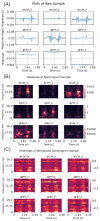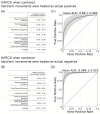Counting Finger and Wrist Movements Using Only a Wrist-Worn, Inertial Measurement Unit: Toward Practical Wearable Sensing for Hand-Related Healthcare Applications
- PMID: 37420857
- PMCID: PMC10300978
- DOI: 10.3390/s23125690
Counting Finger and Wrist Movements Using Only a Wrist-Worn, Inertial Measurement Unit: Toward Practical Wearable Sensing for Hand-Related Healthcare Applications
Abstract
The ability to count finger and wrist movements throughout the day with a nonobtrusive, wearable sensor could be useful for hand-related healthcare applications, including rehabilitation after a stroke, carpal tunnel syndrome, or hand surgery. Previous approaches have required the user to wear a ring with an embedded magnet or inertial measurement unit (IMU). Here, we demonstrate that it is possible to identify the occurrence of finger and wrist flexion/extension movements based on vibrations detected by a wrist-worn IMU. We developed an approach we call "Hand Activity Recognition through using a Convolutional neural network with Spectrograms" (HARCS) that trains a CNN based on the velocity/acceleration spectrograms that finger/wrist movements create. We validated HARCS with the wrist-worn IMU recordings obtained from twenty stroke survivors during their daily life, where the occurrence of finger/wrist movements was labeled using a previously validated algorithm called HAND using magnetic sensing. The daily number of finger/wrist movements identified by HARCS had a strong positive correlation to the daily number identified by HAND (R2 = 0.76, p < 0.001). HARCS was also 75% accurate when we labeled the finger/wrist movements performed by unimpaired participants using optical motion capture. Overall, the ringless sensing of finger/wrist movement occurrence is feasible, although real-world applications may require further accuracy improvements.
Keywords: convolutional neural network (CNN); human activity recognition (HAR); motion capture system (MC); neural network; rehabilitation; stroke; the inertial measurement unit (IMU); wearable sensing.
Conflict of interest statement
David Reinkensmeyer is a co-founder of Flint Rehabilitation Devices: a company that is commercializing rehabilitation technologies. He holds equity and has received payment for consulting from Flint. He also received payment for consulting and holds equity in Hocoma: a manufacturer of rehabilitation technology. The terms of these arrangements have been reviewed and approved by the University of California, Irvine, in accordance with its conflicts of interest policies.
Figures








Similar articles
-
Magnetically Counting Hand Movements: Validation of a Calibration-Free Algorithm and Application to Testing the Threshold Hypothesis of Real-World Hand Use after Stroke.Sensors (Basel). 2021 Feb 22;21(4):1502. doi: 10.3390/s21041502. Sensors (Basel). 2021. PMID: 33671505 Free PMC article.
-
Would a thermal sensor improve arm motion classification accuracy of a single wrist-mounted inertial device?Biomed Eng Online. 2019 May 7;18(1):53. doi: 10.1186/s12938-019-0677-7. Biomed Eng Online. 2019. PMID: 31064354 Free PMC article.
-
Hand Gesture Recognition Using Single Patchable Six-Axis Inertial Measurement Unit via Recurrent Neural Networks.Sensors (Basel). 2021 Feb 17;21(4):1404. doi: 10.3390/s21041404. Sensors (Basel). 2021. PMID: 33671364 Free PMC article.
-
Assessment of movement disorders using wearable sensors during upper limb tasks: A scoping review.Front Robot AI. 2023 Jan 9;9:1068413. doi: 10.3389/frobt.2022.1068413. eCollection 2022. Front Robot AI. 2023. PMID: 36714804 Free PMC article.
-
Chest-Worn Inertial Sensors: A Survey of Applications and Methods.Sensors (Basel). 2021 Apr 19;21(8):2875. doi: 10.3390/s21082875. Sensors (Basel). 2021. PMID: 33921900 Free PMC article. Review.
Cited by
-
A New Successive Time Balancing Time-to-Digital Conversion Method.Sensors (Basel). 2023 Dec 8;23(24):9712. doi: 10.3390/s23249712. Sensors (Basel). 2023. PMID: 38139557 Free PMC article.
-
Tai Chi Expertise Classification in Older Adults Using Wrist Wearables and Machine Learning.Sensors (Basel). 2024 Jul 31;24(15):4955. doi: 10.3390/s24154955. Sensors (Basel). 2024. PMID: 39124002 Free PMC article.
-
A Novel Framework Based on Deep Learning Architecture for Continuous Human Activity Recognition with Inertial Sensors.Sensors (Basel). 2024 Mar 29;24(7):2199. doi: 10.3390/s24072199. Sensors (Basel). 2024. PMID: 38610410 Free PMC article.
References
MeSH terms
LinkOut - more resources
Full Text Sources
Medical
Miscellaneous

